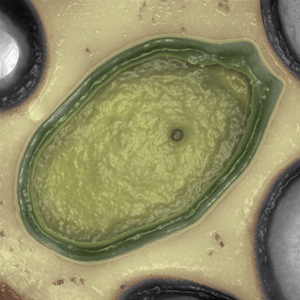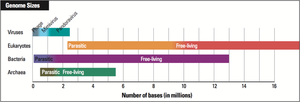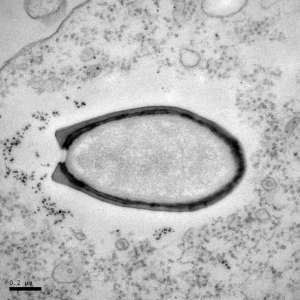Pandoravirus salinus
Virus Classification

Group: I (dsDNA viruses)
Family:Pandoraviridae
Genus:Pandoravirus
Species:Salinus
Species genus: Pandoravirus salinus
Description and Significance
Pandoravirus salinus is the largest known virus to date. It is found in the sediments of Chile coastal area by Jean-Michel Claverie and Chantal Abergel, evolutionary biologists at Aix-Marseille University of France. The largest know virus on Earth is classified as Group I virus under the Baltimore Classification. The existence of Pandoravirus salinus hint the unknown parts of the tree of life and also suggest the existence of the fourth domain because only 7% of their genes match those in existing databases [6]. P. salinus might be ignored in the past or classified as bacteria due to their lack of regular geometries. However, with its novel morphological features and genetic code twice the size of Megavirus, pandoraviruses will spark a whole new range of questions to the abiding question of the origins of life on Earth [1].
Give a brief description of the microorganism and explain why you think it is important. How does it relate to the other organisms in its phylum (bacteria and fungi) or group (archaea, virus, protist). Use the following for each reference in text (change number accordingly)--> [1]
Structure, Metabolism, and Life Cycle

The size of P. salinus is 1 μm long and 0.5 μm across, which is large enough to be observe under a bright field microscope [2] & [6]. What's fascinating about the P. salinus is that they have an arsenal of 2,556 genes compared with the flu's 7 or HIV's 9 [3]. According to the researchers that discovered the largest known virus off the coast of central Chile, the virus happens to have no morphological or genomic resemblance to any previously defined virus families. ??? Their micrometer-sized ovoid particles contain DNA genomes of at least 2.5 and 1.9 megabases, respectively [3].
Pandoravirus salinus do not make their own proteins, produce energy via ATP synthesis or reproduce by dividing. However, they contain some of the core genes that are common to other giant viruses. They survive through a typical viral life cycle. Under an electron microscope, the researchers witnessed how Pandoravirus salinus inject themselves to an Amoeba hosts. After entering the host, P. salinus empty their own proteins and DNA into the host, hijack the host's nuclei and producing hundreds of new viral particles and. The final stage of the viral life cycle would be to lyse the host cells open [6].
Interesting features of its structure; how it gains energy (how it replicates, if virus); what important molecules it produces (if any), does it have an interesting life cycle?
Ecology and Pathogenesis

It is reported that the virus was isolated from the mouth of Chile's Tunquen River located in central of Chile [4]. Furthermore, another member of the Pandoravirus genus, Pandoravirus dulcius were found in a freshwater pond near Melbourne, Australia [4]. Therefore, their habitat is most likely to be in water. Based on Claverie and Abergel's observation, they observed that the Pandoraviruses parasitize amoebas. Thus, it is concluded that the P. salinus infect their host via lytic life cycle. Additionally, the researchers who responsible for the the discovery say that these megaviruses, which live underwater, are so far harmless to mankind [3].
Natural habitat (soil, water, commensal of humans or animals?)
If relevant, how does this organism cause disease? Human, animal, or plant hosts? Important virulence factors, as well as patient symptoms.
References
[1] Anon. Scientists find new giant Pandoravirus unlike any known. <http://www.digitaljournal.com/article/354786>. Accessed 2013 July 21.
[2] Anon. Pandora Virus is New Domain of Life. Las Vegas Guard. Express. <http://guardianlv.com/2013/07/pandora-virus-is-new-domain-of-life/. Accessed 2013 July 20.
[3] Anon. Don’t freak out, but scientists have discovered a giant virus. msnNOW. <http://now.msn.com/pandoravirus-is-a-giant-virus-discovered-thats-1000-the-size-of-the-flu>. Accessed 2013 July 20.
[4] Anon. Biggest Virus Yet Found, May Be Fourth Domain of Life? Natl. Geogr. <http://news.nationalgeographic.com/news/2013/07/130718-viruses-pandoraviruses-science-biology-evolution/>. Accessed 2013 July 20.
[5] Philippe N, Legendre M, Doutre G, Couté Y, Poirot O, Lescot M, Arslan D, Seltzer V, Bertaux L, Bruley C, et al. 2013. Pandoraviruses: Amoeba Viruses with Genomes Up to 2.5 Mb Reaching That of Parasitic Eukaryotes. Science 341:281–286.
[6] Yong E. 2013. Giant viruses open Pandora’s box. Nature. <http://www.nature.com/news/giant-viruses-open-pandora-s-box-1.13410>. Accessed 2013 July 20.
[*] EXAMPLE ONLY. REPLACE WITH YOUR REFERENCES. Takai, K., Sugai, A., Itoh, T., and Horikoshi, K. 2000. "Palaeococcus ferrophilus gen. nov., sp. nov., a barophilic, hyperthermophilic archaeon from a deep-sea hydrothermal vent chimney". International Journal of Systematic and Evolutionary Microbiology. 50: 489-500. http://ijs.sgmjournals.org/cgi/reprint/50/2/489
Author
Page authored by Mei Kuen Tang, student of Mandy Brosnahan, Instructor at the University of Minnesota-Twin Cities, MICB 3301/3303: Biology of Microorganisms.
